Beyond the Grave - Institute for Biblical Research
Beyond the Grave - Institute for Biblical Research
Beyond the Grave - Institute for Biblical Research
Create successful ePaper yourself
Turn your PDF publications into a flip-book with our unique Google optimized e-Paper software.
138 Bulletin <strong>for</strong> <strong>Biblical</strong> <strong>Research</strong> 2<br />
human corpses to <strong>the</strong> elements, ra<strong>the</strong>r than burying <strong>the</strong>m. 130 He<br />
surmises that Ezekiel might have visited or heard of funeral grounds<br />
such as <strong>the</strong>se, and that <strong>the</strong> prophet's vision echoes <strong>the</strong> Zoroastrian<br />
belief that one day <strong>the</strong> bones will be reassembled and revived.<br />
There is no a priori reason why Ezekiel could not have incorpo-<br />
rated Iranian notions into his message <strong>for</strong> rhetorical effect, even as he<br />
makes use of Mesopotamian, Syrian and Phoenician ideas elsewhere.<br />
In fact <strong>the</strong> mono<strong>the</strong>ism and ethical character of this religion render it<br />
much more compatible with Yahwism than <strong>the</strong> o<strong>the</strong>r pagan ideolo-<br />
gies. However, not only does Lang not answer <strong>the</strong> chronological 131<br />
and conceptual 132 objections to <strong>the</strong> <strong>the</strong>ory of Iranian influence that<br />
have been raised previously, 133 his suggestion that Ezekiel may have<br />
been familiar with, and may even have visited Zoroastrian funeral<br />
grounds is speculative wishful thinking. This would have required<br />
visionary translocation far to <strong>the</strong> nor<strong>the</strong>ast of <strong>the</strong> exilic community to<br />
<strong>the</strong> land of Persia, a land which no o<strong>the</strong>r Israelite had ever visited.<br />
Fur<strong>the</strong>rmore, <strong>the</strong> reference to hahărûgîm, "<strong>the</strong> slain," in 37:9 rules out<br />
Beatific Afterlife, 57-59. Cf. also G. Widengren. "Israelite-Jewish Religion," Religions of<br />
<strong>the</strong> Past (Historia Religionum 1; ed. C. J. Bleeker and G. Widengren; Leiden: Brill, 1969)<br />
311-12; Birkeland, "Belief in <strong>the</strong> Resurrection," 60-78. Cf. also M. Nobile, who relates<br />
<strong>the</strong> motif of resurrection in Ezekiel 37 to <strong>the</strong> annual Iranian festival of Farvardigān<br />
("Influssi Iranici nel Libro di Ezechiele?" Antonianum 63 [1988] 449-57).<br />
130. Lang, "Street Theater," 310-12. Cf. Herodotus, Histories 1.140. For a descrip-<br />
tion of Zoroastrian funeral practices see Mary Boyce, A History of Zoroastrianism<br />
(Handbuch der Orientalistik 1/8/1; Leiden/Köln: Brill, 1975) 325-30. Cf. also J. R.<br />
Russel, "Burial iii. In Zoroastrianism," Encyclopaedia Iranica (ed. E. Yarshater; London/<br />
New York: Routledge Kegan Paul, 1982) 4.561-63.<br />
131. It is unclear when <strong>the</strong> doctrine of <strong>the</strong> resurrection of <strong>the</strong> dead was devel-<br />
oped in Persian religion. The earliest certain reference derives from <strong>the</strong> Greek<br />
Theopompus (born circa 380 B.c.). The citation by Aeneas of Gaza in Theophrastus 77<br />
reads as follows:<br />
And yet even Plato brings back Armenius in bodily <strong>for</strong>m from Hades to <strong>the</strong><br />
land of <strong>the</strong> living. And Zoroaster prophesies that some day <strong>the</strong>re will be a res-<br />
urrection of all dead. Theopompus knows of this and is himself <strong>the</strong> source of in-<br />
<strong>for</strong>mation concerning it <strong>for</strong> <strong>the</strong> o<strong>the</strong>r writers.<br />
No explicit contemporary Persian attestation is known.<br />
132. Whereas <strong>the</strong> Old Testament concentrates on life be<strong>for</strong>e death, <strong>the</strong> Persian<br />
attention is focused on life after death. The Old Testament has no counterpart to <strong>the</strong><br />
Persian view of <strong>the</strong> separation of body and soul. The Persian focus on judgment im-<br />
mediately after death contrasts with <strong>the</strong> Israelite, and specifically Ezekielian view of<br />
Sheol as a place of shadowy existence. When <strong>the</strong> doctrine of judgment emerges it is<br />
seen as an eschatological event. Perhaps <strong>the</strong> most important difference is <strong>the</strong> Israelite<br />
interest in reconciliation with God and <strong>the</strong> remission of sins, notions which have no<br />
parallel in Persian thought.<br />
133. See <strong>the</strong> critique of F. Konig, Zarathustras Jenseitsvorstellungen und das Alte<br />
Testament (Wien: 1964), 271-85. Cf. also Spronk, Beatific Afterlife, 58.

















